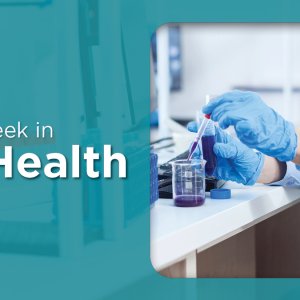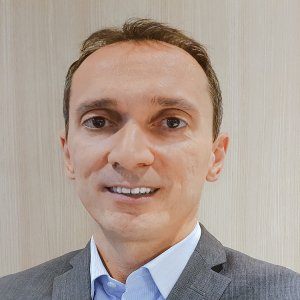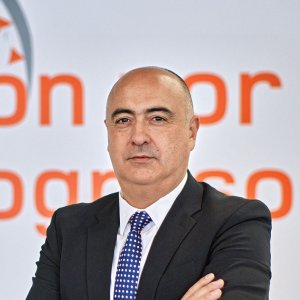Digitalization is increasingly becoming an essential element in providing comprehensive care, improving patient’s experience and bringing innovative medicines and medical devices closer to those who need them most. It also supports doctors and hospitals in their daily tasks so they can focus exclusively on the patient. In this environment, Mexico Business News is organizing a webinar that will gather healthcare leaders to discuss the role of digitalization in improving healthcare practices and providing better care for patients.




Digitalization: The Future of Patient Care
 By Miriam Bello | Senior Journalist and Industry Analyst -
Wed, 08/26/2020 - 14:03
By Miriam Bello | Senior Journalist and Industry Analyst -
Wed, 08/26/2020 - 14:03
Artificial intelligence, digitalization and IoT take on a big role in creating personalized care solutions that transform a patient’s lifestyle and reduce costs for healthcare systems around the world. What are the main challenges that can be overcome through the digitalization of healthcare? During the webinar Digitalization: The Future of Patient Care, organized by Mexico Business News and sponsored by Dassault Systèmes, digitalization leaders participating in the healthcare sector discussed this futuristic version of patient care.
Roberto Aguilera, Health Sciences & Wellness Consulting Partner, EY Latam North and moderator of the panel, asked participants how have companies adopted digitalization and what are the next steps towards an optimal digital environment? “While I have not seen a fully digitalized company yet, I am sure that this will not take long to happen as companies are starting to acknowledge the importance of data and how this makes processes efficient,” said Gino Scarangella, VP Life Sciences NAM of Dassault Systemes. Gino explained that for a company to fully adopt digitalization, it needs to understand the value it will bring to its performance. “Digitalization offers technology transfer, manufacturing efficiency and knowledge sharing. It is important to take advantage of this digital thread from the beginning to transform it into care provision.” Scarangella highlighted the value of engagement that companies need to have to make digitalization a culture within a company. “The best way to change business processes is by making it a culture, beyond just applying the knowledge,” he said.
Charles Nader, CEO of Doc.com, put the future of health into perspective. “We all know where we want to go and we have seen in movies and series how everything can be digitized. We have movies like Prometheus, where the patient enters a machine that scans them and helps to determine ailments and heal them,” he said. Although digitalization has become a more widespread concept, COVID-19 has boosted its importance. “In the past, it was uncertain how long digitalization would take to permeate a company. Now, the process has been accelerated,” said Jorge Camargo, Co-Founder and Co-CEO Ecaresoft Inc.
“Technology meeting patient care should be the ideal goal for any company within the sector,” said Aguilera, who then asked the panelists about the role digitalization will play in the customization of healthcare solutions and treatments and the speed of their delivery. To answer this question, Scarangella brought to the table the Living Heart Project that Dassault Systèmes has created by simulating a living heart, which can serve for pharmaceutical and medical devices to deliver better results. “Through the Living Heart Project, we can determine what would work for the patient specifically. This reduces generic solutions with unknown effectiveness until the patient goes through the treatment,” he said.
Meanwhile, Camargo introduced what would be the “holy grail” of technology in healthcare. “The goal is to have cheaper health (because it increases access) with higher quality of services. This is where digitalization can boost the sector to put it closer to the goal.” However, Camargo explained that so far, even when having positive results, things are not chaining regarding the true purpose of technology in health. “Instead of digitalization making health more accessible, health seems to be getting more expensive. As providers, we need to take a step back and really focus on the patient’s health and increasing access to treatments and solutions,” he said.
Panelist also discussed what best practices should be followed to make digitalization a competent ally for healthcare professionals. Scarangella said this is an expensive feat but a very beneficial one for the company’s performance. “Best practices start with a plan on how to take advantage of digitalization and where it can have the greatest impact. As a provider, you want to look at risks or slower processes to able to improve them.” According to Scarangella, not all digitalization is a science project. Best practices can be found in production lines and some companies find those areas to be the most valuable for clients.
Beyond companies, Nader sees another area of opportunity for technology to truly change the sector. “To see technology as an ally, you need to think beyond the traditional mindset. There are many new solutions that can sometimes be limited because of regulations. New solutions require new regulations to be really successful and truly impact the patient,” he said.
Camargo recommended companies to keep in mind their goals when delving into digitalization. “This needs to be seen as any other decision a company can take, so there is no need to see it as a complex solution. Digitalization is intended to be a tool to improve performance and remain competitive,” he said. The resulting impact will be a new differentiator beyond sales. “Companies should start aligning their goals to the patient. This would be a key determinant for healthcare because if the company meets its goals, then the patient is cured,” said Camargo.
You May Like
Dassault Systèmes: Business Solutions Through Smart Data Use

STORY INLINE POST
Q: How does the company bring technology and innovation to pharma and biotechnology companies?
A: Dassault Systèmes views life sciences in three significant sectors: pharma and biotechnology, medical devices, and patient care. With our recent acquisition of Medidata in October of 2019 we really expanded our capacity, which allowed us to focus on this new market. Prior to 2013, DASSAULT SYSTEMES focus was on medical devices manufacturing and R&D in medical equipment.
In 2012, following the acquisition of companies like Accelyrs, Dassault Systèmes’ life sciences vision broadened to include biotech and pharma. The Accelyrs became the BIOVIA brand. With the addition of BIOVIA, and other brands like DELMIA, ENOVIA, EXALEAD, SIMULIA AND CATIA, we could take our successes in other industries, and leverage the LifeSciences know how that the now BIOVIA brand brought to the company, and from there began the path that would later introduce our customers into the digital age within life sciences.
Dassault Systèmes has the capacity to break down barriers currently blocking companies because of the siloed solutions that have been deployed for so many years, by leveraging a platform architecture that connects applications so they may share data across the spectrum of the different work cycles within life sciences. This allows companies to take advantage of data flow across the entire business to increase productivity and reduce the time from ideation to actual production. This eventually leads to a drop in R&D costs and a much faster delivery of therapies to patients.
With pharmaceutical companies, it is common to have sufficient data collected throughout the years across many projects, and yet companies find themselves redoing many of the experiments they have done because they cannot access all the information gathered and stored, because it is easier to redo the experiment than search through their own data pools. Our task here is to enable them to access that data and show them how, through technology, they can continuously improve their processes and performance through better data access and collaboration.
The goal in leveraging all of our tools lead us to our ability to support the market of patient care. With the acquisition of Medidata, Dassault Systèmes can now directly support how the inclusion of clinical data in conjunction with all of the other elements in the lifecycle for developing therapies and devices impacts patient care. With this, we are also able to leverage IoT for patient care and develop mechanisms to demonstrate the building process of a medical device that will become a tool to treat the patient. Getting data continuously and directly from patients is also a plus that technology can offer. To date, there are several apps and wearables that allow people to track their own vital signs and habits, which is of great value to medical professionals who can, in turn, deliver a more accurate diagnosis based on the person’s accumulated data, instead of basing the diagnosis on just the most recent symptoms or vital signs.
Q: How do Dassault Systèmes’ solutions for medical devices improve performance?
A: In the past, we had a strong product life-cycle management suite that worked from R&D to manufacturing. Data was key during this process. Allowing data to transfer freely from when you are ideating on what product to create, through manufacturing and distribution offers a huge added value to the customer. Dassault Systèmes has tied all those pieces together through state-of-the-art applications that can work with a company to also simulate the production process so clients can see what this will involve before they start operations. Thus linking the virtual and the real. Moreover, we show MedDevice companies how to take advantage of the digitalization of all their processes across all work streams enabling them to become more efficient. An example: within warehouses the automation of certain processes or the correct collection of data uses information productively, and accurately, taking away mistake driven rework, and increases overall efficiency. Improving technology within a warehouse does not only improve efficiency but it also lowers costs and increases workers’ safety.
For Dassault Systèmes, it is very important to first understand the processes of the customer instead of just jumping in with precanned solutions. Our expertise and ability to consult with our customers, allows us to better understand and recommend the right process and technology to support a long-term sustainable solution. By leveraging this approach, we adapt our services to solve problems without being a disruptive force.
Q: How is your 3DExperience solution a differentiator for Dassault Systèmes?
A: 3DEXPERIENCE connects the company’s different work streams, across business operations and transforms them into a unified engine, focused on reaching the company’s goals. It enables the sharing of all relevant information, whether it relates to the manufacturing process or R&D data, and increases its value by being accessible and useful to the people that leverage it. One example is our work with a pharmaceutical that currently in clinical testing their new treatments to fight COVID-19, without a digital framework to do that, finding all the relevant data to derive a new therapy from the research of past experiments and therapy data would be much slower and complicated.
Having an interconnected process with elements that recognize different data components and how they affect the business, increases efficiency and reduces costs. Customers that have adopted our solutions have reduced their time to market by 20 to 35 months and increased their probability of success by over 30 percent. Costs reductions, conservatively, can be between five and 10 percent per year and overall, quality risks can fall by over 25 percent.
Q: How are Dassault Systèmes digital tools helping to grow healthcare access?
A: We have a very successful example in our Living Heart project. Through this solution, companies can create a simulation of an individual’s heart and then look for positive treatments. Medical devices companies use this to make sure their products work as designed. For the medical professional that is actually performing the work, this solution may enable them to take the data collected from the patient and project it into the Living Heart system. This could allow Surgeons to use a heart model driven by the data from their patient to practice before the actual surgery.
Dassault Systèmes also has a Living Brain project that delivers a simulation of the brain and also allows surgical simulations for medical professionals, or even determining the efficacy a drug has getting past the blood brain barrier. With the participation of more companies, we could even develop full body projects to ensure a safer performance for the medical professional and the patient.
Q: How is Dassault Systèmes contributing to fight COVID-19?
A: Our clients from the automotive industry started an initiative to collaborate and manufacture ventilators with our customers in the healthcare sector. Our solution had what it takes to support the design and approach to build those ventilators. We were able to put both parts together and show them how to get from point A to point B in the fastest way possible. The cloud was leveraged, to share supportive digital tools during this period which enabled quicker communications and transfer of information and designs. We also helped during manufacturing trainings to ensure and support business continuity.
Additionally, we enabled our customers, to leverage existing data of therapies that could be useful in helping COVID-19 patients. There is no cure yet but some treatments are out there that targeted similar symptoms and many companies are taking a look at how to follow up on those past developments, to see if they apply.
Another way we helped our customers, focused on business continuity, especially in the supply chain, which was disrupted during the pandemic as some global suppliers stopped exports, or shut down completely. We helped our customers through planning in supply operations find other suppliers manage labor resources, to continue working even amid staff shortages when some employees had to be sent home due to vulnerability to the virus or because of social distancing measures.
I am proud to note, that within our own company, we tried to transmit confidence to our employees and enable our own business continuity while taking measure for the safety of those who still had to tackle essential work.
Q: What are Dassault Systèmes’ near-term plans?
A: We want to showcase how our platform can help companies build and leverage ideas for the benefit of the patient. We will continue to develop ideas that focus on impacting patients through the smart and effective use of data, and the digitization of the work enterprise within life science companies. In the end, our goal is to ensure that, through technological support, companies can deliver better personalized health, better patient experiences and improve access to therapies for people.
Dassault Systèmes is a Dassault Group subsidiary that focuses on software that transforms the way products are designed, manufactured and supported. Dassault Systèmes’ collaborative solutions foster social innovation, expanding the possibilities of the virtual world to improve the real world
You May Like
How COVID-19 Accelerated Digital Transformation in Healthcare

STORY INLINE POST
Q: What digital trends are reshaping the health industry?
A: At EY, we have found that doctors and patients understand that technology will redefine their relationship and experience. A survey we conducted before the pandemic found that doctors and patients agree that digital tools used on a regular basis can greatly influence and contribute to healthcare, but there is a great deal that still needs to be done. Technology adoption within the healthcare sector has historically been slower in Mexico because doctors and other entities in the sector take their time adapting to emerging changes. However, according to the international survey, industry players are now prioritizing future investment and incorporation of technology into their practices.
Technologies that increase patient security are among the strongest trends as they provide clinical excellence and facilitate communication with providers and consumers. Previously, technologies that could help to better approach the patient, like telemedicine, were neglected. With COVID-19, however, telehealth has quickly accelerated its market penetration. Before the pandemic, 64 percent of doctors were not planning, in the near future, to introduce virtual consultations or digital check-ups nor to use voice-controlled digital assistants. Our survey indicated that around 60 to 80 percent of doctors were now very open and willing to incorporate new technologies into their practices. However, positive responses dropped by 20 to 40 percent when asked about their willingness to use specific technologies, such as remote robotic surgeries or to move completely toward remote medical consultations as a way to increase healthcare access in rural areas that lack health infrastructure.
Q: What are the main obstacles preventing the digital transformation of hospitals in Mexico?
A: Medical professionals have a great deal of say on new technologies because their goal is to provide excellence in their practice. In Mexico, the approval from healthcare services is based on hospital productivity: having high bed occupancy numbers, full consultancy schedules, a productive ICU and a high number of patients being treated. Therefore, any new technology or digital tool is expected to comply with the productivity and quality standards that the sector is used to.
One common example of digitalized practices at a hospital is the use of an electronic clinical record. Patients themselves do not notice any benefit from its use, at first. However, hospital staff do experience an improvement in their productivity. In the long run, patients also experience the benefits because they are able to receive more personalized and adequate attention. That being said, it is sometimes hard for hospitals to perceive these benefits initially because what comes first is investment in time and money to adapt to this new system.
Q: How is EY contributing to the digital and technological transformation in healthcare?
A: Globally, EY is dedicated to analyzing the evolution of the healthcare system, recognizing that it is evolving to a patient-centric model with the creation of Healthcare 4.0 that, at the same time, is focused on promoting preventive healthcare. Before the pandemic, we conducted another survey called NextWave to measure how the provision of healthcare has changed. The findings are particularly interesting in today’s context because we see that all those long-term plans for the sector are happening right now or will happen within the coming months. One example is telehealth.
The digital transformation is accelerating at up to three times the usual rate, meaning that the expectation for the sector is a digital-centric care model, from digital delivery of healthcare to digital interactive tools to facilitate remote consultations. At EY, we support and guide companies during this transformative process. In Mexico, we are consultancy leaders in healthcare and we are looking forward to becoming leaders in transformation.
EY had a recent success with the government of Chile, where we worked together to create an alternative method to support its healthcare systems amid the pandemic. Alongside the Chilean authorities, we created a digital solution that allowed remote guidance through an app. Through artificial intelligence, the app detects possible COVID-19 cases as Chilean users are asked to fill in a survey about their current health status. When detecting a case, the app is able to provide digital consultations with a doctor to confirm if the person is COVID-19-positive. If the doctor has high suspicions of contagion, they recommend taking the test or going to a medical facility to address any symptoms or complications. This app has elevated COVID-19 testing in Chile and has also resulted in more manageable flows of patients, who cannot visit a medical facility without a previous digital approval to do so.
In Mexico, we were able to support our hospital clients during the reconversion of their facilities to treat COVID-19 patients. It was very interesting to see that the biggest challenge that we normally face when trying to introduce digital practices into hospitals was the first one to fall away: cultural resistance. By breaking this barrier, we were able to introduce telehealth, telemedicine solutions and electronic clinical records. This was a remarkable step because once the tools are already there, we can begin taking action to improve operations and encourage the hospital to see the benefits of those tools that they were reluctant to incorporate in the past. Introducing these technologies could have taken up to 10 years. Now that we have broken through, our job is to improve these technologies.
Q: What other healthcare trends should Mexico be adopting?
A: Personalized care is the future of healthcare. Traditionally, all patients suffering from the same ailment receive the same treatment but efficacy varies depending on the person. Personalized health means taking healthcare to the patient’s home, because providers need to understand the patient’s context and characteristics to be able to adapt to their lifestyle and deliver personalized attention and follow-up. Technology is the ideal tool to ensure a correct diagnosis and follow-up on the patient. Sometimes, it can predict the effectiveness of a treatment and at the same time determine the doses and duration of the treatment for each patient. In healthcare, time and cost can make a huge difference.
Q: What are the ideal educational actions to encourage technology use and development in Mexico?
A: Mexico has great doctors and health professionals who have even been recognized internationally. However, they are still learning traditional practices and methods. Educational programs could start introducing new practices that include technology use and development. Furthermore, I think it is key to start including innovation in academic programs regardless of the career. This would give students an early introduction to technology and they can start to think of ways to use it, improve it and develop their own tools.
Universidad Panamericana, for example, offers optional health subjects to engineering students to build their knowledge of healthcare. I think this initiative is very helpful and sets the stage for innovative developments in the healthcare sector.
Ernst & Young (EY) is one of the world's leading professional services firms. It offers auditing, tax, finance, accounting, legal advice, actuarial study and calculation services, as well as company management consulting
You May Like
Boosting R&D Through Software-Based Visibility

STORY INLINE POST
Q: How is Dassault Systèmes working to promote Industry 4.0 principles in Mexico?
A: Our goal is to transform jobs so that people engage in added-value activities related to customer experience, while automating other processes and developing schemes where humans and machines collaborate to increase efficiency. We developed the “Industry of the Future” concept that puts human beings at the core of the 4.0 revolution. In Mexico, aerospace and automotive remain our core industries but other sectors, such as energy and consumer products, are gaining momentum.
Q: How does Dassault’s 3DEXPERIENCE platform help companies improve their design and engineering processes?
A: Our platform creates a collaborative environment that factors in many more elements that previously would not be considered. For instance, companies can now reflect comments from social media when developing the next generation of their products. Similarly, having several areas of a company collaborating simultaneously helps an organization reduce its engineering costs, response times and ppm rates while increasing product quality from a component’s design stage.
Q: What gaps in Mexico’s automotive industry are addressed by the implementation of the 3DEXPERIENCE platform?
A: One of the most important areas of opportunity to bring more Mexican suppliers into the industry is the lack of standardized processes that could offer certainty to OEMs. 3DEXPERIENCE is the best possible communication link between OEMs and their suppliers because it ensures designs, simulations and working plans are shared among companies. This gives OEMs the certainty that they are working with suppliers that have formal, well-defined processes. We are launching new cloud-based software packages so SMEs can access this technology and can be in direct communication with their Tier 1 or OEM clients.
Since all companies involved are aware of the final result that must be achieved, they can start performing analysis of weight, performance and design and manufacturing times. In Mexico, BMW and Ford are among the companies already implementing this platform.
Q: What new opportunities are EVs bringing to Dassault Systèmes?
A: Developing local suppliers that can support EV assembly has become a challenge for Ford. Vehicle electrification will transform the automotive industry into a high-tech sector. This is a great area of opportunity for Dassault Systèmes because 98 percent of all vehicle-electrification startups now use the company’s 3DEXPERIENCE platform. Mexico needs to train its talent so the people producing combustion engines and other components can answer to the new needs of the automotive industry and produce components for EVs.
Q: What role does Dassault Systèmes play in talent development?
A: In September 2018, Dassault Systèmes signed an agreement with the Ministry of Economic Development of the State of Mexico, the Automotive Cluster of the State of Mexico and the Autonomous University of the State of Mexico (UAEM) to create capable talent to develop EVs and self-driving cars. Dassault Systèmes will open two technology areas at UAEM so the university can start training students in the use of new manufacturing technologies. We plan to replicate the success of a similar program implemented in Wichita, Kansas. The company’s 3DEXPERIENCE Center focuses on the aerospace industry and several companies are taking advantage of it to carry out their R&D operations.
Q: How will the new trade environment resulting from USMCA impact Dassault Systèmes’ operations in North America?
A: Dassault Systèmes de México now competes with its US and Canada counterparts in terms of developing local suppliers. The country that manages to develop suppliers the fastest will capture a greater percentage of regional content production. For Mexico to keep its productivity level, the country needs to secure more contracts to supply components.
Q: What are your growth expectations for 2019?
A: We achieved our 20 percent growth goal for 2018. While 3Q18 was challenging because of changes in the energy sector that impacted Dassault Systèmes energy-oriented operations, the aerospace and automotive industries remained strong. We expect to maintain this momentum through 2019 and achieve a similar growth rate with these sectors as our most important revenue generators. We expect energy activities to remain on sluggish but the consumer goods area is likely to increase in importance as consumer habits change.
Mergers and acquisitions will also play an important role in the company’s growth strategy. The goal is to make Dassault Systèmes a US$10 billion company by 2023, up from its 1Q19 value of US$4 billion. I expect new acquisitions will be announced every quarter.
Dassault Systèmes is a French software developer that offers solutions for 3D design and product life-cycle management. Its 3DEXPERIENCE platform allows companies to optimize design and manufacturing processes
















































 By Alejandro Salas | Managing Editor -
Fri, 03/29/2019 - 05:00
By Alejandro Salas | Managing Editor -
Fri, 03/29/2019 - 05:00






